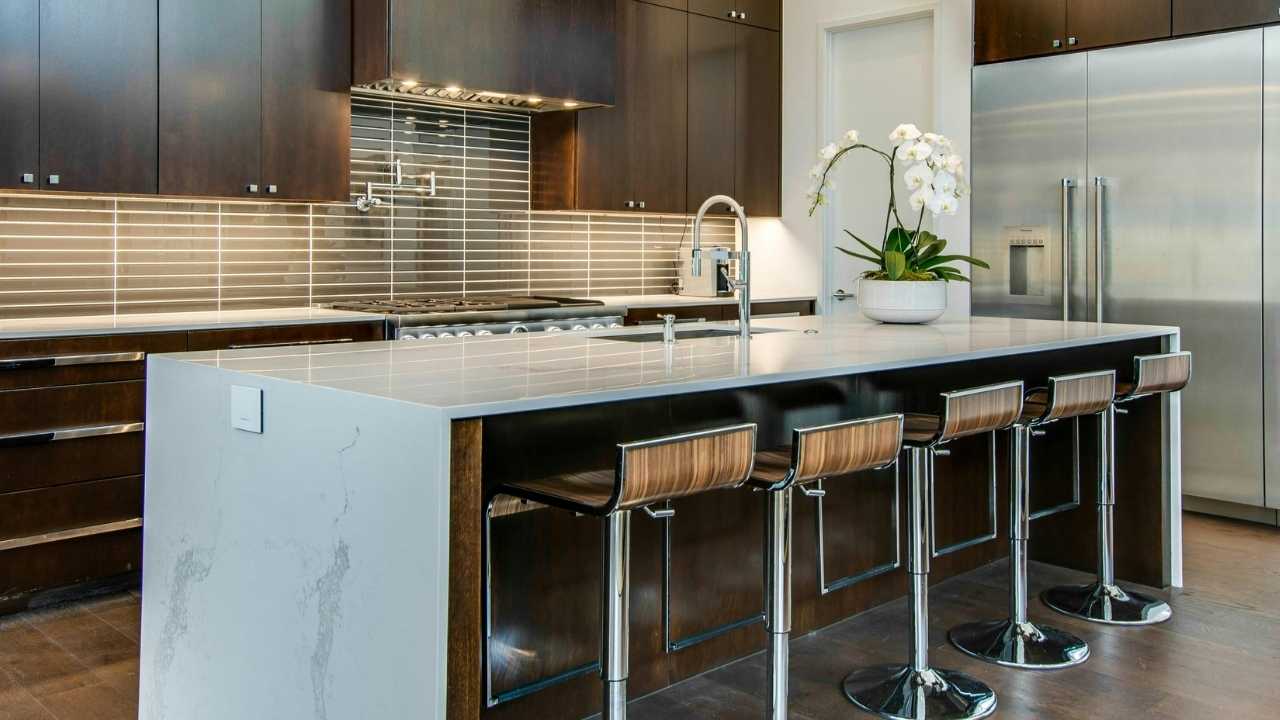A well-designed kitchen island serves as the centerpiece of a modern culinary space. Whether used for food prep, casual dining, or entertaining guests, the surface material chosen plays a crucial role in both aesthetics and performance. Selecting the right material can enhance workflow, reflect personal style, and align with long-term goals. At AP Advanced, our home remodeling services ensure that every element—from your island to your layout—works in harmony to create a kitchen that’s both beautiful and functional.
In this guide, we’ll explore 20 kitchen island countertop materials suitable for various price points, lifestyles, and design preferences. From budget-conscious selections to luxury finishes, each material comes with its strengths, visual appeal, and maintenance requirements.
1. Granite: Classic Durability with Natural Variation
Granite remains one of the most popular materials for kitchen islands due to its strength and unique appearance. Each slab features natural veining and color variation, offering a one-of-a-kind style. It resists heat and scratching but requires periodic sealing to prevent staining. Ideal for traditional or transitional designs needing long-term performance.
2. Quartz: Engineered Elegance and Low Maintenance
Quartz countertops are made by combining crushed natural stone with resin, resulting in a durable, non-porous surface. Unlike natural options, quartz offers consistency in color and pattern. It resists stains, doesn’t require sealing, and holds up under heavy use—a top contender for the best material for kitchen island countertops in busy family homes.
3. Marble: Sophisticated Appeal with Subtle Veining
Marble delivers unmatched luxury through its soft veining and luminous surface. It suits upscale kitchens or baking zones where cool surfaces are ideal. However, it scratches and etches easily, making it a high-maintenance material. Best used where aesthetic value outweighs wear concerns, such as in decorative or secondary island tops.
4. Butcher Block: Warm, Inviting, and Practical
Wood countertops made from maple, oak, or walnut add warmth and natural texture. Butcher block suits farmhouse and transitional kitchens while providing a soft surface for prep work. Regular oiling prevents drying or cracking. It’s an affordable, renewable choice and a staple in mixed-material kitchen island designs.
5. Stainless Steel: Industrial Strength and Hygiene
Stainless steel countertops offer a sleek, modern surface that’s non-porous and easy to disinfect. Common in commercial kitchens, it withstands heat, water, and frequent use. Fingerprints and scratches develop over time, adding patina. Ideal for contemporary homes or cooking-focused islands demanding resilience and simplicity.
6. Concrete: Bold, Customizable, and Textural
Concrete countertops bring raw, industrial charm and allow full customization in shape, finish, and pigment. When sealed properly, they resist moisture and stains. Their weight requires reinforced cabinetry, and hairline cracks may form over time—a compelling best material for kitchen island top in modern or artistic interiors.
7. Soapstone: Subtle Beauty and Chemical Resistance
Soapstone features soft, matte veining and darkens naturally with age. It resists heat, acids, and staining, making it a durable, low-maintenance choice. Unlike harder stones, it may nick or dent slightly but can be sanded smooth. Excellent for homeowners seeking a timeless, understated countertop with tactile appeal.
8. Laminate: Economical and Versatile
Laminate surfaces consist of plastic layers bonded over particleboard, offering an affordable variety in texture, color, and pattern. While not as heat- or scratch-resistant as stone, modern laminates convincingly replicate the appearance of wood, marble, or granite. Ideal for budget-conscious renovations or short-term solutions where cost efficiency is a top priority.
9. Tile: Customizable Design and Affordable Material
Ceramic or porcelain tile countertops offer creative freedom in terms of color, pattern, and layout. Tiles resist heat and can be replaced individually if damaged. However, grout lines require regular upkeep to prevent staining or mold growth. Well-suited for retro or Mediterranean-style kitchens with an emphasis on color and personalization.
10. Glass: Clean, Contemporary, and Reflective
Tempered glass countertops offer a smooth, modern finish with high visual impact. They’re resistant to heat and staining but show fingerprints and smudges easily. Available in clear, frosted, or back-painted styles, glass works well in minimalist kitchens where clean lines and light reflection enhance space.
11. Reclaimed Wood: Eco-Conscious and Textured
Reclaimed wood adds historic character and sustainability to kitchen islands, enhancing their aesthetic appeal and environmental impact. Each plank carries signs of age, creating a tactile, lived-in feel. Requires sealing to protect against moisture and food spills—an excellent option in mixed-material kitchen island configurations, paired with stone or metal for added contrast.
12. Acrylic Solid Surface: Seamless and Repairable
Solid surface materials, such as Corian, consist of acrylic and natural minerals, allowing for seamless joins and integrated sinks. They’re stain-resistant, non-porous, and easy to resurface if scratched. While less heat-resistant than stone, solid surfaces offer clean aesthetics and customizability—a reliable, mid-range solution for contemporary kitchens.
13. Quartzite: Natural Stone with High Durability
Often confused with quartz, quartzite is a natural stone known for its extreme hardness and crystalline appearance. It resists heat, scratches, and UV damage, making it suitable for islands exposed to direct sunlight. More expensive than granite but equally durable, quartzite strikes a balance between elegance and rugged performance.
14. Porcelain Slab: Ultra-Compact Surface with Modern Appeal
Porcelain countertops are crafted from dense, fired ceramic, often printed to resemble the appearance of marble or concrete. They’re ultra-thin, lightweight, and incredibly heat- and scratch-resistant. Ideal for waterfall island designs or sleek, contemporary spaces. Minimal maintenance and bold looks make it a rising star among kitchen island countertop materials.
15. Zinc: Living Surface with Organic Aging
Zinc countertops develop a natural patina over time, transitioning from a bright silver to a warm gray-blue hue. Used often in Parisian kitchens and vintage-inspired homes, zinc is antimicrobial and food-safe. It scratches easily but adds character. Works best in designs where aging surfaces complement rustic or old-world aesthetics.
16. Granite Composite: Engineered Strength for High-Traffic Use
Granite composite materials mix natural stone with resin, forming a dense, non-porous surface. Used in both sinks and countertops, they provide resilience against scratches, stains, and heat. Available in matte finishes and dark tones, they suit families needing functional surfaces that don’t compromise on visual appeal.
17. Copper: Warm-Toned Metal with Antimicrobial Benefits
Copper countertops offer a reddish-gold tone that darkens beautifully over time. Naturally antimicrobial and heat-resistant, copper surfaces develop a unique patina in each space. They scratch and dent easily, but for some, that’s part of their charm. Ideal for vintage or eclectic island applications.
18. Epoxy Resin: High-Gloss and Artistic Flexibility
Epoxy-coated surfaces can mimic the look of granite, marble, or feature completely abstract designs with high-gloss finishes. Heat- and stain-resistant, epoxy suits custom designs and DIY remodels. Best applied over wood or laminate cores. Maintenance is minimal, but reapplication may be necessary over time to maintain the finish’s clarity and strength.
19. Terrazzo: Decorative Aggregates with Modern Flair
Terrazzo combines chips of marble, glass, or quartz set in a cement or epoxy matrix, creating a multicolored, speckled surface. Durable and visually rich, it suits contemporary or retro interiors. Although more commonly used in flooring, terrazzo countertops bring a playful and personal touch to kitchen islands that seek a unique focal point.
20. Lava Stone: Glazed Surface with Rare Visual Impact
Lava stone countertops are hand-glazed and kiln-fired, producing a glossy, crackled surface that’s heat- and stain-resistant. Imported and handcrafted, they come at a premium but offer bold color options and artisanal craftsmanship—an exceptional choice for showpiece islands where artistry and performance come together.
Matching Material to Lifestyle, Function, and Aesthetic Goals
Choosing the best material for a kitchen island depends on usage habits, design preferences, and budget limitations. Homes with heavy cooking routines may prioritize durability and hygiene, favoring materials such as quartz, stainless steel, or concrete. For visual impact, marble, terrazzo, or lava stone creates dramatic statements.
Designers often opt for mixed-material kitchen island layouts to combine form and function, pairing wood tops with stone prep zones or blending metal with solid surfaces. This approach enhances flexibility while layering textures and tones.
Whether seeking the best material for a kitchen island top to support casual dining, meal prep, or display, understanding the properties of each surface ensures the investment aligns with your long-term kitchen goals.
Make the Island the Heart of Your Kitchen Remodel at AP Advanced
A well-designed island can redefine your kitchen. At AP Advanced, we guide you through choosing the right island countertop while rethinking the entire layout to boost function and flow. Visit our Jacksonville showroom to explore material options, receive expert advice, and begin planning your comprehensive kitchen remodel with confidence.

